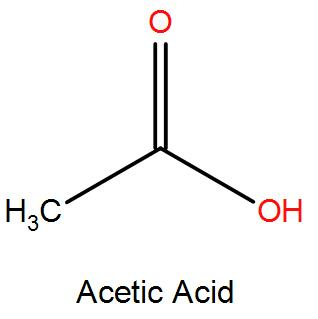Answer
39.3k+ views
Hint: We know that the basicity of an acid is the number of replaceable hydrogen atoms that are present in a molecule of that acid. Hence an acid that contains only one replaceable hydrogen atom in its molecule is known as a monobasic acid and its basicity is 1. Similarly, the acid which contains two replaceable hydrogen atoms in its molecule is called a dibasic acid and its basicity is 2. With this concept in mind, we will be solving the given question where we have to first know about the molecular structure of Acetic Acid and then find how many hydrogen atoms it replaces to find its basicity.
Step by step answer: Acetic Acid has a total of 4 hydrogen atoms and 2 carbon atoms with functional group oxygen present in its molecular structure as we can see below. The dissociation formula of acetic acid is also given as follows:
$\text{C}{{\text{H}}_{3}}-\text{COOH }\xrightarrow{{}}\text{ C}{{\text{H}}_{\text{3}}}\text{CO}{{\text{O}}^{-}}\text{ }+\text{ }{{\text{H}}^{+}}$

4 hydrogen atoms being present in the molecule of Acetic Acid, it only has one replaceable hydrogen ion present in it. Hence giving only one ionizable ${{\text{H}}^{+}}$ ion, hence its basicity is 1.
So we can determine that the basicity of Acetic acid is 1 because it releases one hydrogen ion in an aqueous solution.
Therefore, the correct option is Option A.
Note: The less electronegative the element, the less stable the lone pair will be and therefore the higher will be the basicity. Even though it’s a weak acid, at high concentrations it will be corrosive on skin. The household vinegar consists of Acetic acid as a primary ingredient.
Step by step answer: Acetic Acid has a total of 4 hydrogen atoms and 2 carbon atoms with functional group oxygen present in its molecular structure as we can see below. The dissociation formula of acetic acid is also given as follows:
$\text{C}{{\text{H}}_{3}}-\text{COOH }\xrightarrow{{}}\text{ C}{{\text{H}}_{\text{3}}}\text{CO}{{\text{O}}^{-}}\text{ }+\text{ }{{\text{H}}^{+}}$

4 hydrogen atoms being present in the molecule of Acetic Acid, it only has one replaceable hydrogen ion present in it. Hence giving only one ionizable ${{\text{H}}^{+}}$ ion, hence its basicity is 1.
So we can determine that the basicity of Acetic acid is 1 because it releases one hydrogen ion in an aqueous solution.
Therefore, the correct option is Option A.
Note: The less electronegative the element, the less stable the lone pair will be and therefore the higher will be the basicity. Even though it’s a weak acid, at high concentrations it will be corrosive on skin. The household vinegar consists of Acetic acid as a primary ingredient.
Recently Updated Pages
silver wire has diameter 04mm and resistivity 16 times class 12 physics JEE_Main

A parallel plate capacitor has a capacitance C When class 12 physics JEE_Main

A series combination of n1 capacitors each of value class 12 physics JEE_Main

When propyne is treated with aqueous H2SO4 in presence class 12 chemistry JEE_Main

Which of the following is not true in the case of motion class 12 physics JEE_Main

The length of a potentiometer wire is 10m The distance class 12 physics JEE_MAIN

Other Pages
Differentiate between homogeneous and heterogeneous class 12 chemistry JEE_Main

A closed organ pipe and an open organ pipe are tuned class 11 physics JEE_Main

Formula for number of images formed by two plane mirrors class 12 physics JEE_Main

Electric field due to uniformly charged sphere class 12 physics JEE_Main

Explain the construction and working of a GeigerMuller class 12 physics JEE_Main

How many grams of concentrated nitric acid solution class 11 chemistry JEE_Main



